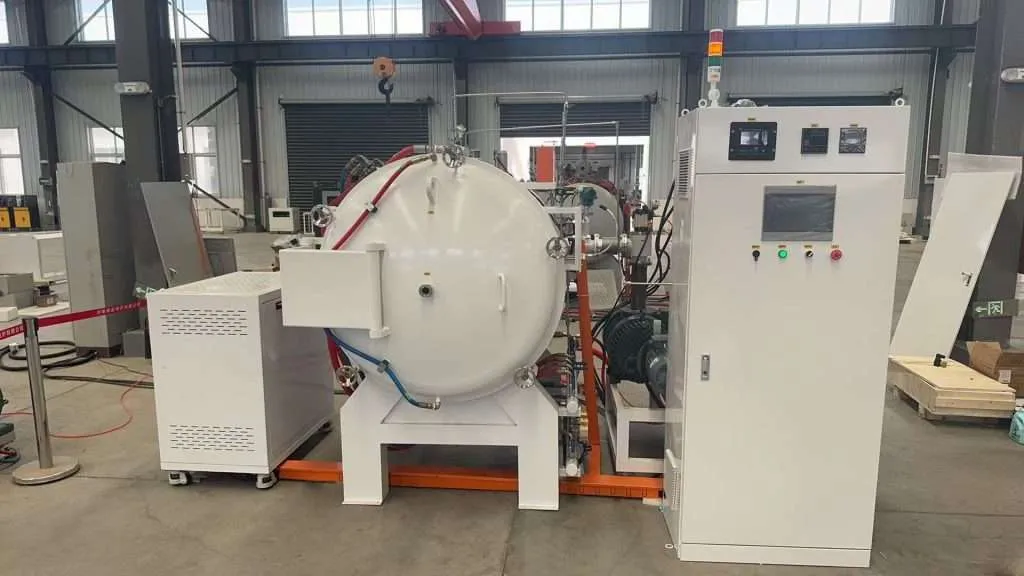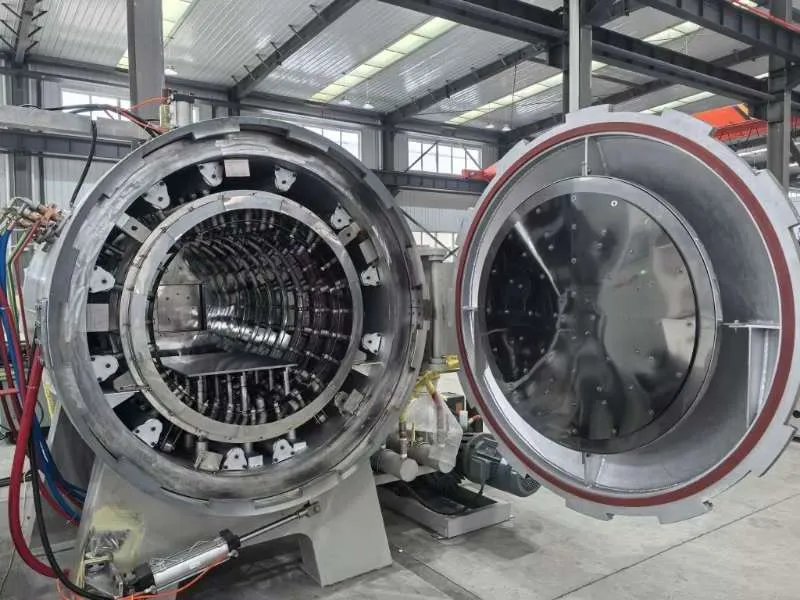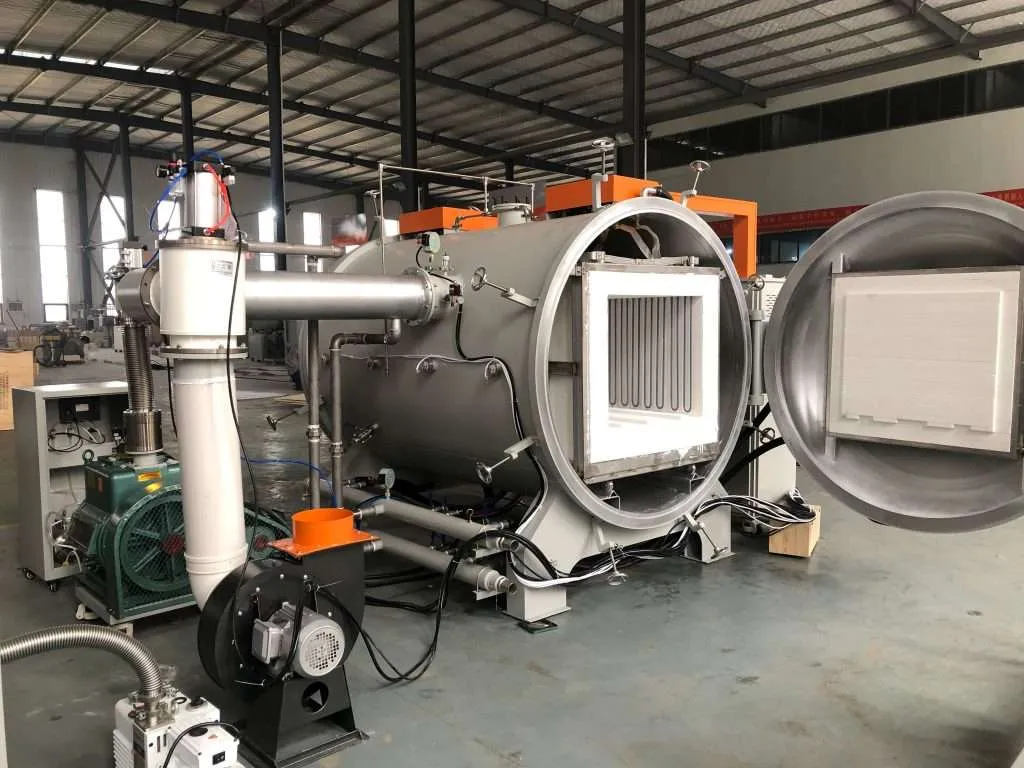Here are 10 FAQ (Frequently Asked Questions) about Laboratory Vacuum Furnaces.
1. What is a laboratory vacuum furnace and what are its primary applications?
A laboratory vacuum furnace is specialized equipment that heats materials to high temperatures within a controlled vacuum environment. This specific atmosphere is crucial for preventing oxidation, contamination, and other undesirable chemical reactions that can manifest when materials are heated in the presence of ambient air. Key components typically include a robustly sealed chamber, an efficient heating system, reliable vacuum pumps, and precise control instrumentation. These furnaces are indispensable tools in various scientific research and industrial development sectors. Their primary applications encompass critical heat treatment processes such as annealing, hardening, tempering, and stress relieving of diverse metals and alloys. Additionally, they are extensively employed for high-integrity brazing, advanced sintering of ceramics and powdered metals, thorough degassing of materials to enhance purity, and controlled crystal growth for specialized electronic or optical components, particularly where maintaining material purity is absolutely paramount.
Crucial Information:
Heats materials to elevated temperatures under a precisely controlled vacuum.
Prevents oxidation, contamination, and unwanted reactions during thermal processing.
Widely used for annealing, brazing, sintering, degassing, and materials research.
2. How does a vacuum environment benefit material processing in these furnaces?
A vacuum environment offers several significant benefits for material processing when conducted within a laboratory furnace. Primarily, it effectively eliminates or substantially reduces the presence of atmospheric gases, notably oxygen and nitrogen, thereby actively preventing oxidation, nitridation, and other unwanted chemical interactions with the material undergoing processing. This careful control results in cleaner material surfaces, demonstrably improved material purity, and consequently, enhanced physical or chemical properties. Furthermore, a vacuum atmosphere can greatly facilitate critical processes like outgassing, which involves the systematic removal of trapped gases or volatile impurities from the bulk of the material. The marked absence of convective heat transfer in a high vacuum environment also permits more uniform heating profiles and allows for exceptionally precise temperature control throughout the thermal cycle.
Crucial Information:
Prevents oxidation and other detrimental reactions by removing reactive atmospheric gases.
Facilitates outgassing, leading to significantly higher material purity and improved end-properties.
Enables more uniform heating distribution and highly precise temperature control due to reduced convection.
3. What are the key components of a typical laboratory vacuum furnace?
A typical laboratory vacuum furnace comprises several essential components that must work in precise concert to achieve desired processing conditions. The core of the unit is the vacuum chamber, a meticulously sealed vessel specifically engineered to withstand both high operational temperatures and significant vacuum pressures without compromise. Inside this chamber, a sophisticated heating system, often consisting of resistive elements made from refractory metals or graphite, or alternatively induction coils, provides the necessary thermal energy for the process. An integrated vacuum pumping system, usually a combination of roughing pumps (like rotary vane pumps) and high-vacuum pumps (such as diffusion or turbomolecular pumps), is responsible for evacuating the chamber to the required vacuum level. Temperature sensors, typically thermocouples, and various pressure gauges continuously monitor the internal conditions, while a comprehensive control system, often PLC-based, manages all operational parameters including temperature ramps and vacuum levels. A dedicated cooling system, which might involve water jackets or controlled gas quenching, is also vital for managing controlled cooling cycles post-processing.
Crucial Information:
A robust, sealed vacuum chamber designed to sustain high temperatures and deep vacuum.
An internal heating system (e.g., resistive elements or induction coils) and a multi-stage vacuum pumping system.
Comprehensive instrumentation (temperature sensors, pressure gauges) and an advanced control system for precise operational management.
4. What types of heating elements are commonly used in laboratory vacuum furnaces?
Laboratory vacuum furnaces utilize various types of heating elements, with the selection carefully based on the maximum required operating temperature, compatibility with the process atmosphere and materials, and overall cost-effectiveness. Molybdenum (Mo) and tungsten (W) metallic elements are frequently chosen for high-temperature applications, typically exceeding 1200°C, due to their exceptionally high melting points and desirably low vapor pressures under vacuum conditions. Graphite elements are also widely implemented, especially in inert gas backfilled or vacuum environments, offering excellent thermal uniformity, rapid heating and cooling rates, and good mechanical stability at high temperatures. For lower temperature ranges, generally below 1200°C, metallic alloys such as Kanthal (FeCrAl) or Nichrome (NiCr) may be employed; however, their use in vacuum environments requires careful consideration due to potential outgassing or reactivity concerns at elevated temperatures. The specific choice of heating element profoundly impacts the furnace’s performance, longevity, and suitability for particular processes.
Crucial Information:
Molybdenum (Mo) and tungsten (W) elements are standard for very high-temperature operations.
Graphite elements provide excellent thermal uniformity and are common in inert gas or vacuum conditions.
Metallic alloys like Kanthal or Nichrome are viable options for lower temperatures but need careful evaluation for vacuum compatibility.
5. What are the different vacuum levels achievable and their significance?
Laboratory vacuum furnaces are engineered to achieve a range of vacuum levels, which are generally categorized as low, medium, high, and ultra-high vacuum, each significant for different types of processes. Low vacuum (approximately 1 Torr down to 10-3 Torr) is often sufficient for simple degassing operations or preventing gross oxidation of less sensitive materials. Medium vacuum (typically 10-3 Torr to 10-6 Torr) offers substantially better protection against contamination and is commonly used for processes like annealing, sintering, and brazing of many engineering materials. High vacuum (ranging from 10-6 Torr to 10-9 Torr) becomes critical when processing highly reactive metals, performing advanced sintering, or in applications demanding exceptional material purity and minimal residual gas presence. Ultra-high vacuum (UHV) levels, which are below 10-9 Torr, are typically reserved for highly specialized research applications, such as surface science studies or molecular beam epitaxy, demanding extremely clean and controlled environments. The required vacuum level directly influences the complexity, design, and cost of the associated vacuum pumping system and chamber construction.
Crucial Information:
Vacuum levels span from low vacuum (offering basic atmospheric protection) to ultra-high vacuum (ensuring extreme purity).
Medium vacuum levels are generally suitable for common industrial processes like general annealing and brazing.
High and ultra-high vacuum levels are indispensable for processing reactive materials, achieving high-purity outcomes, and conducting specialized research.
6. What safety precautions are essential when operating a laboratory vacuum furnace?
Operating a laboratory vacuum furnace necessitates strict adherence to a comprehensive set of safety precautions to effectively mitigate potential operational risks. All personnel involved must be thoroughly trained on the furnace’s specific standard operating procedures (SOPs) and clearly defined emergency protocols before undertaking any operation. The presence of extremely high temperatures requires the mandatory use of appropriate personal protective equipment (PPE), including items such as heat-resistant gloves, protective aprons, and full-face shields, to prevent severe thermal burns. Electrical safety is absolutely paramount, given the significant electrical power often involved in heating systems; therefore, regular and diligent inspection of all wiring, connections, and safety interlocks is crucial. Users must also be acutely aware of the implosion risks associated with vacuum chambers, particularly those equipped with glass viewports, and diligently ensure the structural integrity of the chamber before each use. Proper, cautious handling of hot materials post-processing and a keen awareness of potential outgassing of hazardous or flammable substances from processed materials are also critical safety considerations that demand constant vigilance.
Crucial Information:
Comprehensive operator training on SOPs and emergency procedures, alongside mandatory use of appropriate personal protective equipment (PPE).
Strict adherence to electrical safety practices and regular, thorough inspection of all furnace components and safety interlocks.
Vigilant awareness of potential implosion risks, safe hot material handling techniques, and management of potentially hazardous outgassing products.
7. How is temperature controlled and monitored in a laboratory vacuum furnace?
Temperature control and meticulous monitoring within a laboratory vacuum furnace are accomplished through a sophisticated, integrated system designed for precision and reliability. Thermocouples, such as refractory metal types like Type C (Tungsten-Rhenium) or noble metal types like Type S (Platinum-Rhodium), are commonly utilized as primary temperature sensors; these are strategically placed within the hot zone to measure either the workpiece temperature or the ambient chamber temperature accurately. These sensors transmit continuous feedback signals to a programmable logic controller (PLC) or a dedicated digital temperature controller. This controller then intelligently regulates the power supplied to the heating elements, frequently employing advanced PID (Proportional-Integral-Derivative) control algorithms, to precisely follow a user-defined, pre-set temperature profile, which may include multiple ramps and soaks. For non-contact temperature measurement, especially at very high temperatures where thermocouples may degrade or for specific material types, optical pyrometers can also be effectively integrated into the system.
Crucial Information:
Thermocouples (e.g., Type C, Type S, Type K) serve as the primary temperature sensors, providing critical feedback to the control system.
Programmable controllers (PLCs or dedicated units) utilize sophisticated algorithms like PID to precisely regulate power delivery to the heating elements.
Optical pyrometers offer valuable non-contact temperature measurement capabilities, particularly suitable for extremely high temperatures or specific process conditions.
8. What maintenance procedures are typically required for laboratory vacuum furnaces?
Regular and diligent maintenance is absolutely crucial for ensuring the long-term reliable, safe, and efficient operation of laboratory vacuum furnaces. These procedures typically include the periodic inspection and thorough cleaning of the vacuum chamber interior to remove any accumulated process residues or contaminants that could affect future runs. Vacuum pumps, a critical subsystem, require routine checks of oil levels and quality (for oil-sealed mechanical pumps) and timely replacement as per manufacturer recommendations, along with continuous monitoring of overall pumping performance to detect degradation. All seals, gaskets, and O-rings within the vacuum system must be regularly inspected for any signs of wear, cracking, or damage and replaced proactively to maintain optimal vacuum integrity and prevent leaks. Heating elements themselves may need periodic visual inspection for signs of degradation, such as distortion or thinning, and eventual replacement to ensure consistent heating performance. Furthermore, the periodic calibration of critical instrumentation, including temperature sensors and vacuum gauges, is essential for maintaining accurate process control and ensuring reproducible results.
Crucial Information:
Consistent cleaning of the vacuum chamber interior and diligent inspection/maintenance of all components of the vacuum pumping system.
Regular checking and proactive replacement of worn seals, O-rings, and potentially degrading heating elements.
Scheduled periodic calibration of temperature sensors (thermocouples, pyrometers) and vacuum gauges to ensure sustained accuracy.
9. What considerations should be made when selecting a laboratory vacuum furnace for a specific application?
Selecting the most appropriate laboratory vacuum furnace for a specific application or range of applications involves a careful evaluation of several critical considerations. The maximum required operating temperature and the necessary ultimate vacuum level are primary determining factors, as these will dictate the choice of heating element materials, insulation package, and the complexity and type of vacuum pumping system needed. The physical dimensions of the chamber, including its usable hot zone volume and overall configuration (e.g., front-loading, top-loading, bottom-loading), must adequately accommodate the workload dimensions and any specific processing requirements like fixture integration. The compatibility of the furnace’s internal construction materials (chamber walls, hearth, insulation) with the process materials and any potential off-gassing chemical byproducts is also a vital consideration to prevent unwanted reactions or contamination. Furthermore, the desired level of process automation, stringent temperature uniformity requirements across the hot zone, achievable heating and cooling rate capabilities, and, naturally, the available budget and laboratory space will significantly influence the final selection decision.
Crucial Information:
Clearly define the maximum operating temperature, required ultimate vacuum level, and necessary chamber size based on precise application needs.
Thoroughly ensure material compatibility between the furnace components, the materials to be processed, and any generated gaseous byproducts.
Carefully consider the desired level of automation, temperature uniformity specifications, controlled cooling rates, allocated budget, and physical space constraints.
10. What are some common troubleshooting issues encountered with laboratory vacuum furnaces?
Common troubleshooting issues encountered during the operation of laboratory vacuum furnaces frequently relate to difficulties in achieving or subsequently maintaining the desired vacuum level within the chamber. Such problems can often stem from insidious leaks in the chamber body itself, compromised seals around doors or feedthroughs, or performance issues with the vacuum pumps, such as worn components or contaminated pump oil. Difficulty in reaching the programmed target temperature, or unusually slow heating rates, might indicate developing issues with the heating elements (e.g., partial failure or increased resistance), problems with the main power supply system, or malfunctions within the temperature control instrumentation or its logic. The occurrence of non-uniform heating across the workload could be due to partial degradation of heating elements, improper load placement affecting radiation or convection patterns, or issues with hot zone insulation. Unexpected contamination of processed samples often points towards inadequate prior chamber cleaning, internal material outgassing from fixtures or insulation, or a persistent small leak introducing contaminants. Consulting the manufacturer’s detailed operational and troubleshooting manual and employing systematic diagnostic checks are key strategies to effectively identify and resolve these common issues.
Crucial Information:
Inability to achieve or effectively maintain the target vacuum level is frequently caused by system leaks or vacuum pump malfunctions.
Temperature attainment or stability problems can arise from faulty heating elements, issues with the power supply, or errors in the control system.
Sample contamination issues may often result from insufficient chamber cleaning, outgassing from internal components, or undetected micro-leaks.
